|
The Development of Chinese Records to 1911
by Du Jun Min
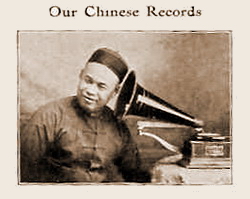
|
|
Original photo of the "Velly Good Talkee" trademark
Catalogue supplement, June 1905
|
|
|
In the first decade of the 20th century, on
the eve of a regime change in China from
the Qing Dynasty to the Republic of China
(1912-1949), almost all of the world's leading
record companies came to China and Hong
Kong for recording business. Even though
very few records made during this period have
survived, we are still able to outline clearly the
history and development of the early recording
industry in China.
When we talk about the birth of the record
market in
China, we
must mention
in particular
one person and
one disc. This
person was a
Frenchman
named E.
Labansat who
launched the
initial sales of
records in China
by playing his
own disc, titled
"JOYEUX
RIRES"
(a laughing
record), to
the public on
the streets
of Shanghai.
He set up an
outdoor stall on
Tibet Road to
play this record,
and said that
"anyone who is
able to resist laughing when hearing this record
does not need to pay fees, otherwise, a 10 cents
coin need to pay". Without exception, this disc
has become the first milestone in the history
of Chinese records. Nowadays, many Chinese
people older than 60 are still able to remember
this remarkable record. Its name was translated
into Chinese as "Yang Ren Da Xiao", or "Five
People Laughing", which means "Laughing
Foreigners". Bearing catalogue number 32606,
it was first issued on the French Pathé label
as an 11.5"
vertical-cut
record with an
etched label
(fig. a). Around
1918 or 1919,
and for many
years after
that, it was
issued in the
same format
but with a
Chinese paper
label, Yang Ren
Da Xiao (fig.
b). Some ten
years later it
was re-issued
in a lateral-cut
format, 10
inches in size,
with a new,
Chinese paper
label, Yang
Ren Da Xiao,
in a variety of
blue, orange
and black colors.
Pathé sold
its records in China through
its office in Shanghai. Some
years later they set up their
own factory in Shanghai and
became the most important and
biggest record factory in China
until RCA built its factory
in Shanghai at the beginning
of 1930 and became Pathé's
strongest competitor.
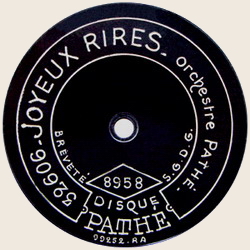
|
|
Fig.a. Joyeux Rires 11.5" Etched-label, double-sided
|
|
|
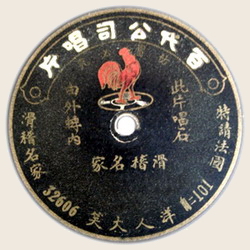
|
|
Fig.b. "Yang Ren Da Xiao" 11.5" paper-label
(Courtesy of Wang Yue Jin)
|
|
|
G&T
The earliest discs recorded in Chinese
territory were by Fred Gaisberg for The
Gramophone & Typewriter Company
Limited
between
March 18th
and April 26th,
1903. A total
of 476 records,
titled in
Chinese, were
listed in its
1904 Chinese
catalogue.
Three hundred
and twenty-nine
Mandarin
dialect records
were recorded
in Shanghai
and one hundred and forty-seven
Cantonese
dialect records
were recorded
in Hong Kong.
These discs
were issued
in 7" and 10"
sizes with the
"Recording
Angel"
trademark on the
reverse (fig. c). Matrix numbers
E429 to E618 were used for
190 10" records and E1503
to E1788 for 286 7" records.
According to the agreement
made between The Gramophone
& Typewriter Company and
the Victor Talking Machine
Company on August 3, 1904,
some of these records were
first re-issued by Victor in
America in 1904. These reissues
carry "Velly Good Talkee" trade marks
on a label depicting a Chinaman listening to a
Gramophone. The earliest issues of this label
were cream-white
in color; later
issues appeared
in a yellow
color. (fig.d)
Fred Gaisberg's
recordings and
trips to China
were arranged
by Moutrie &
Co., a British
Company
originally
established in
1875 that began
commercial
business in
gramophones
and records
in Shanghai
in early 1906.
Moutrie & Co.
later became
the first and
exclusive
sales agent
for Victor's
gramophones
and records for the entire Chinese market. Its
Chinese name, "MOUDELI", has long appeared
on the labels of early Victor records. In 1925-26
its Chinese factory was set up in Shanghai to
produce pianos and organs.
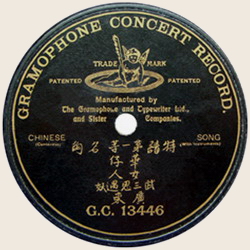
|
|
Fig.c. G&T Chinese record 10" single-sided, ca. 1903
|
|
|
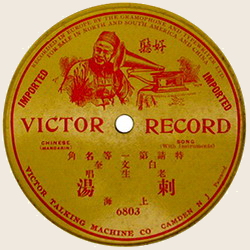
|
|
Fig.d. re-issued from G&T matrix 10" single-sided, ca. 1904 (a later "Velly Good Talkee" yellow label)
|
|
|
Victor
The earliest disc records made for Chinese
people were made between August 1902 and
May 1903 by the early Chinese Colony in
America and issued by Victor in the United
States. These records appeared in a Monarch
10" series, 164 records of 32 Chinese titles
(fig.e). They were sold basically to the Chinese
Colony in North America, so are rarely seen
in China and Chinese society in
Southeast Asia. This series was
originally numbered in different
blocks between 1557 and 2371,
then renumbered in 1903 from
7160 to 7323. A second lot of
similar Chinese records was
made just 3 months later, in
August, with 59 records of 6
Chinese titles, numbered from
7101 to 7159. Their labels were
identical to the earlier Monarchs.
Two sessions recorded 223
records of 38 titles. Some copies of
later issues from my collection
indicate that these earliest
Monarch Records were re-issued
in 1904 with the yellow "Velly
Good Talkee" trade mark label.
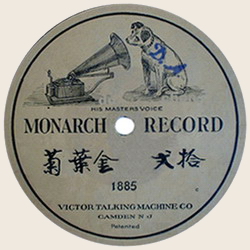
|
|
Fig.e. Monarch 10" single-sided earliest Victor Chinese record, ca. 1902
|
|
|
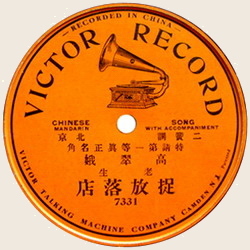
|
|
Fig.f. Victor 10" single-sided first records recorded in China, ca. 1905
|
|
|
Victor's first discs recorded
within Chinese territory were in
Shanghai in the first half of 1905
(fig.f). Their labels appeared in
a 7324- 8299 series and show
different colors such as orange,
green, silver, and later light
blue, etc. They were later re-issued
in the period from 1907 to 1909 with different
Chinese names such as "Yì Cuò" (fig.g) and
"Wù Kè Duo" (fig.h), which was a Chinese translation of 'Victor' by people who spoke different Chinese dialects.
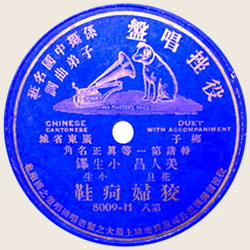
|
|
Fig.g. Victor 10" re-issued as "Yì Cuò", single-sided, ca. 1908
|
|
|
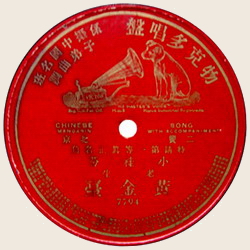
|
|
Fig.h. Victor's 10" re-issued as "Wù Kè Duo", single-sided, ca. 1909
(Courtesy of Wang Yue Jin)
|
|
|
Columbia
As early as 1903, Columbia also recorded some
Chinese records which were issued in a 1260-
1350 series. I have seen more than 17 surviving
copies in this series. All of the titles are of
Cantonese Opera. According to Tim Brooks'
book "The Columbia Master Book Discography
Volume I", they were made in Shanghai in
early 1903 (fig. i). From physical features on
different labels and actual discs
in this series, I believe they
were re-issued at least two times
after their first issues. A copy of
Columbia's Chinese record 1037
survived in excellent condition
and seems a little earlier than
those in 1260-1350 series (fig.
j).
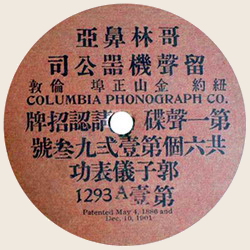
|
|
Fig.i. Columbia 10" single-sided, ca. 1903
|
|
|
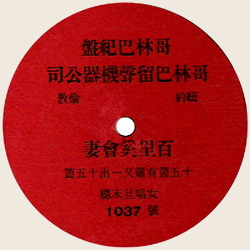
|
|
Fig.j. Columbia 10" single-sided, ca. 1903
|
|
|
By 1906, Columbia had
made more than 1000 records
in China and these recordings
were issued in a 1000, 15000,
57000, and a 60000 series, with
labels designed in different styles.
For example, Dragon label in red
color, American stars and stripes
flag and Chinese Qing-Dynasty's
dragon flag label, Columbia
Concert Record with Lion label,
and so on. They are all single-sided
records. Columbia's record
sales in China were through its
early agent named J. ULLMANN
& Co. from France in the period
from 1905 to 1908 (fig. k) and
later through its new agent named
MUSTARD & Co., after 1908
(fig. l). On its earlier record label
up to 1905, and on its later label
depicting a Chinese golden dragon
on a red and green background, there is no
mention of an agent in China.
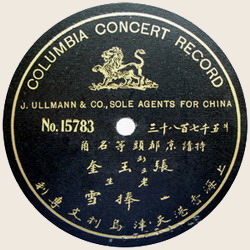
|
|
Fig.k. Columbia 10" single-sided Sold by J.ULLMANN & Co., ca. 1906-1907
|
|
|
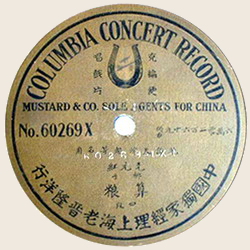
|
|
Fig.l. Columbia 10" double-sided sold by MUSTARD & Co., ca. 1909-1910
|
|
|
Beka, Favorite, Odeon and Lyrophon
Some famous record companies from Europe
were also making Chinese records in Shanghai
and Hong Kong by early 1906. The German
company, Beka, arrived in Hong Kong on
Feb. 18th and Shanghai on March 12th, 1906
and issued more than 500 records in a 19xx
to 24xx block (fig. m). Favorite, another
German company, issued records in 1910,
according to date information on its label.
There is no information when they began
recording activities in China, and their labels
suggest very limited issue (fig. n).
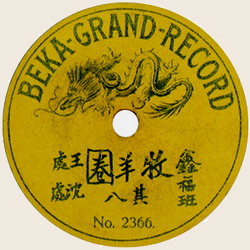
|
|
Fig.m. Beka 10" single-sided, ca. 1906
(Courtesy of Guo Zeng Fu)
|
|
|

|
|
Fig.n. Favorite 10" double-sided, ca. 1910
(author's collection)
|
|
|
Variant labels
from different actual discs indicate that they
were either later re-issued or first issued in
more than one version. Odeon, in 1907, made
double-sided, 11" Chinese records with a very
special Chinese-styled label design (fig. o).
These were later re-issued in a similar design
in different colors (fig.p). Beka and Odeon sold
their records in China through their sales agents
among foreign and local companies.

|
|
Fig.o. Odeon 11" double-sided, ca. 1907
(Courtesy of Dieter Schulze)
|
|
|
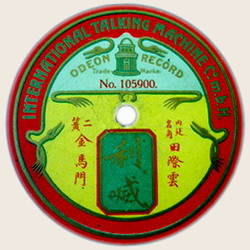
|
|
Fig.p. Odeon 11" double-sided, ca. 1908-1909
(Courtesy of Liu Rui Peng)
|
|
|
Lyrophon
is also a German company that made Chinese
records. Their
records, and those
by Favorite, are
very rare today.
I can find little
information about
Lyrophon's early
recording trips to
China, except an
ad dated August
1913 in "The
Talking Machine
News". The
appearance of the
10" double-sided
record referred to
in the ad is very
interesting. It has
different colors
on its two sides,
and the catalogue
numbers on
each side are
not continuous,
so I doubt that
this was a reissued
copy
from its previous
version which
was probably single-sided. Lyrophon sold its
Chinese Northern music records (fig.q) through
a foreign agent in Shanghai and Chinese
Southern music records (fig.r) through Behr &
Co., in Singapore.
Odeon and Columbia have copies similar to
Lyrophon in special style.
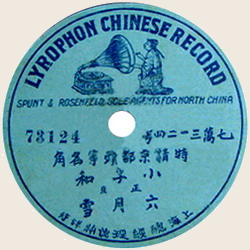
|
|
Fig.q. Lyrophon 10" double-sided, ca. 1913
|
|
|
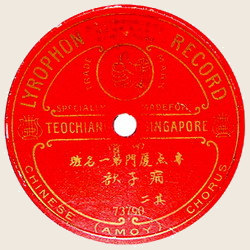
|
|
Fig.r. Lyrophon 10" double-sided, ca. 1913
(Courtesy of Guo ming Mu)
|
|
|
Zonophone
"The Zon-o-phone Record", a book by Ernie
Bayly and Michael Kinnear, mentions that
Universal Talking Machine Manufacturing
Co. made some Chinese records in late 1903
and early 1904 for issue as Zon-o-phone
records. These Chinese records were never
released by Zonophone, but the matrix numbers
used on Victor Chinese records in the 7324-
8299, 9100-9234 and 10000-10350 series are
from those Zonophone recording sessions
(fig. s) and on some re-issues of records in these
Victor series by Gramophone & Typewriter Co.,
Ltd., at least until 1909.
Pathé
Beginning in 1908, Pathé began a massive
schedule of recording in China through its
office set up
in Shanghai in
1907. Pathé's
recordings
covered almost
all early
Chinese famous
Beijing and
Cantonese Opera
performances.
The artists
who made
the recordings
for Pathé served
in Beijing and
Cantonese operas'
famous theatrical
troupes by the
end of the Qing
Dynasty. Some
of them served
as teachers and
performers in the
Beijing Opera
for the Imperial
Palace during the
Qing Dynasty.
The records were
9.5", 11.5" and
14" in diameter, double-sided,
vertical-cut with an etched-label
(fig. t). Pathé's etched-label has
become very popular to many
Chinese collectors.
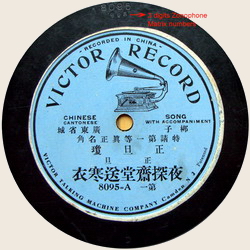
|
|
Fig.s. Victor 10" single-sided with Zonophone matrix number, ca. 1907
|
|
|
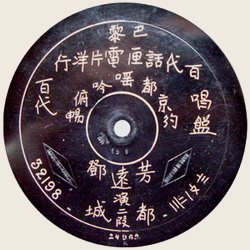
|
|
Fig.t. Pathé 11" double-sided etched-label, ca. 1908
|
|
|
Canadian Berliner and Victor
Let's now talk about Canadian
Chinese records, which is surely
a new topic for most readers.
As a new member of CAPS, I
would like to take this opportunity
to discuss with and learn from
members who know early Chinese
records, or who own copies of records or
paperwork such as catalogues covering early
Chinese records.
By observing and comparing two labels,
we can draw some conclusions about early
Canadian Chinese records. One is Victor
Monarch 1773 (fig.u), which was later renumbered
7184. It was recorded on November
17th, 1902, according to Ted Fagan and
William R. Moran's book "The Encyclopedic
Discography of Victor Recordings – Pre-
Matrix Series". The other is Berliner 5417
(fig. v), which I assume was pressed in 1904
after Berliner had concluded an agreement to
be a distributor of American Victor records.
The Chinese characters that form the titles of
these two records are apparently identical to
each other, including the size of the letters and
the style of handwriting. From this I conclude
that this Berliner Concert-Grand 5417 was
pressed from American Victor's matrix of
1773. It is probably the earliest Chinese record
pressed in Canada. The website of "The Virtual
Gramophone – Canadian Historical Sound
Recordings" has a photograph of a Berliner
Gram-o-phone Company of Canada "Concert
Record - 7173" label with Chinese characters,
circa 1905. The title of this record was also
covered in the early American Victor Chinese
catalogue, so it seem to be another example
of a reissued copy by Berliner Gram-o-phone
Company of Canada of an American Victor
matrix.
Mr. William R. Moran states in Antique
Phonograph News Nov. – Dec. 1992 that "in
1924. …. The company was called 'Victor
Talking Machine Company of Canada Ltd'....
Its products were Canadian-made, and did not
originate in Camden, as did recordings made
for the Chinese trade." Up to now, all Canadian-made
Chinese records I have seen were reissued
from American Victor matrices. For example,
all Canadian-made copies of 42000 and
43000 series records with different colors and
designs of label from "Berliner Gram-o-phone
Co. Limited Montreal" and "Victor Talking
Machine Co. of Canada Limited Montreal" are
from American Victor matrices, and carry the
same catalogue numbers. None of them was
recorded in Canada. All the time I expect to see
an original Canadian-recorded Chinese record
but it seems I have to wait for this dream to be
realized.
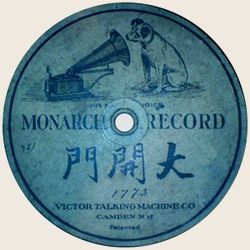
|
|
Fig.u. Monarch 10" single-sided Matrix number 1773, ca. 1902
(Courtesy of Huang Zhi Cheng)
|
|
|
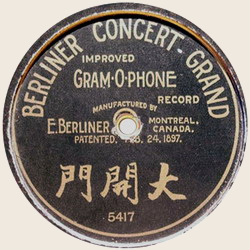
|
|
Fig.v. Berliner 10" single-sided brown color, ca. 1904, reissued from Victor’s matrix 1773
(Courtesy of George Pan, Taiwan)
|
|
|
Other
Mr. Paul Charosh’s book, "Berliner Gramophone
Records, American Issues, 1892-1900", says
that 0402-Chinese Song No.11 and 0444-
Chinese Song No.17 were made by Ching
Ling Foo on Aug 2nd and Aug 10th, 1899. As
a matter of fact, Ching Ling Foo was a very
famous Chinese magician who went to the
United States in 1898. It was said he was
troubled with a stammer, so it’s very hard to
imagine how he was able to record his songs.
[NOTE: It is not uncommon that even bad
stammerers are capable of singing songs
without any noticeable stammer. Perhaps the
combination of a well-known text along with a
well-known tune keeps the stammerer's brain
from feeding back confusion upon itself. -ed]
Mr. Michael Kinnear’s book "The Gramophone
Company’s Indian Recordings 1908 to 1910"
says a 7" Chinese record carrying catalogue
number 10500 was issued by Berliner (first
use, without paper label). This seems to be a
very accidental appearance, perhaps a private
recording; it was not something like an official
recording session of Chinese music. "Vocal
Recordings 1898 – 1925, Volume I, The
Gramophone Company Limited (HMV), English
Catalogue, by John R. Bennett" mentions a
Chinese record with catalogue number 2422
recorded by Snazelle in June, 1900. A Berliner
Chinese record with 15000 as its catalogue
number was mentioned to be made in London,
in February 1899. I think of all of these as
accidental records.
Cylinders
All of the records
mentioned above are
Chinese disc records
and all were pressed
outside China, because
at that early date
China did not yet have
a national recording
industry. Before disc
records became known
to Chinese people,
cylinders carrying
Chinese songs were
known to very few
Chinese families. These
cylinders were made by
Pathé, Edison, private
and unknown companies.
Pathé's cylinders
(fig.w) were recorded in Shanghai, at the turn
of 1900, using blank cylinders. Some private
cylinders from mainland China, Hong Kong,
United States, Europe, etc. were boxed either
hand-written in Chinese or briefly described in
English or without any information (fig.x).
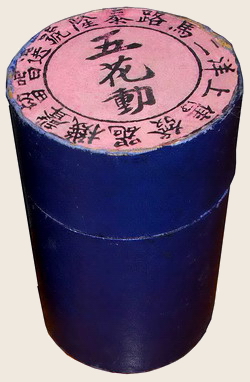
|
|
Fig.w. Pathé cylinder, ca. turn of 1900
|
|
|
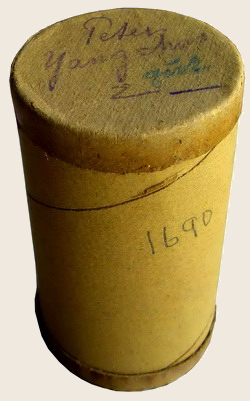
|
|
Fig.x. late private record
|
|
|
Edison's cylinders were official commercial
issues available to the market from early 1903.
Forty-six records with 19 titles appeared in a
red box (fig. y). These were re-issued many
times before 1908 in a common cream-colored
box. In 1909, with the introduction of the
Edison Amberol series, 249 Amberol records
were available in a green box (fig. z). "The wax
cylinders of the Berliner Phonogram Archive"
by Susanne Ziegler introduces many early
Chinese cylinder records, some of them made
by Mr. Berthold Laufer, a German-American, in
Shanghai and Beijing during his expedition to
China in 1901-1903. If Columbia made Chinese
cylinders, it is still unclear.
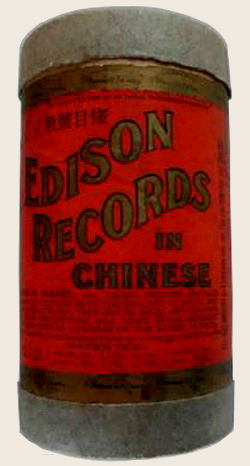
|
|
Fig.y. first issued Chinese cylinder Red box, by Edison, ca. 1903
|
|
|
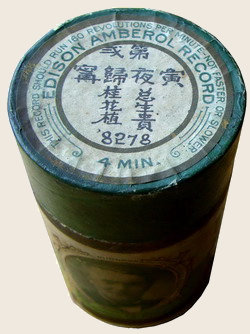
|
|
Fig.z. Amberol Chinese cylinder. green box, by Edison, ca. 1909
|
|
|
Finally, I must give special thanks to Bill Pratt.
Since joining CAPS, he has offered great
assistance to me at any time and encouraged
me to start writing this brief summary of
the historical development of early Chinese
records to 1911. I have had to stop myself from
including too many topics which would have
made this article far too long. I sincerely hope
anyone who is interested in discussing early
Chinese records will contact me at dujunmin@
fibertel.com.ar. I am in fact looking for early
Chinese records (disc and cylinder) and
catalogues around the world. If you have any
available, you are warmly welcome to contact
me.
Sincerely,
DU JUN MIN
Buenos Aires, Argentina
December 2007
|